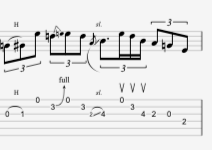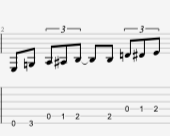Rare Stevie Ray Vaughan Acoustic (Blues Guitar Lesson)
I’ve noticed over the years with guitar players that a lot of them are afraid to play acoustic.
Of course, there are a ton of amazing electric-only players. Like B.B. King. I remember years ago reading an interview with King. In the story, he talked about how Clapton invited him over to work on some songs and just play acoustic. King did it.
But then he said he didn’t want to do it again after. Now obviously King is a master. But there is just something about acoustic guitar that keeps us all honest. And if you don’t have this muscle built up it can be rough. But I’ve also noticed that some of the most heavy-hitting guitar players of all time do both really well.
They can pick up an electric, or unplug and sound amazing either way.
And this is exactly what you will see in this rare Stevie Ray Vaughan acoustic guitar lesson. Now, for the first time ever, I’ll break down this rare acoustic video.
So grab your guitar and let’s dive in!
Chord progression:
Let’s first talk about the chords used in the intro. The entire progression is a blues progression in the key of E. Vaughan kicks off the intro with a 4-bar chord progression. It starts out on an E9 chord. Then moves to an Edim7 chord. And then finally back up to E9 before it goes into the main blues progression for the rest of the jam. Here is how these two chords are played.
E9 is played in the 9th position on the top 4 strings like this:

This is a great blues chord. Vaughan got this shape from Freddie King’s “Hideaway”. It’s the same chord King uses in the big break of the song.
Next is the Edim7. This is played on the same strings. To get there you’ll only need to shift a few notes like this:

These two first chords represent a classic blues move. The basic concept is that you play the I chord in the key (E9). Then make it a diminished seventh (Edim7), and then go back (E9). This can be heard in tunes like “Deep River Blues” and many other older blues tunes.
The other interesting thing about this intro is that Vaughan plays a bar of 4/4 then a bar of 3/4 and then returns back to 4/4 time like this:

After this swinging blues intro, Vaughan kicks into improvising over the main progression for the rest of the video. It is a 12-bar blues, but Vaughan puts his own twist on it and starts on the IV chord (A7).
Here are the two other shapes you’ll need to know A7 and B7.


Vaughan starts with 2 bars of A7, and then 2 bars of E7 like this:
A7 A7 E7 E7
Then that goes again.
A7 A7 E7 E7
After those 8-bars Vaughan finishes it up with a classic blues turnaround in the key of E. Here is where he brings in the V chord (B7) and plays this:
B7 A7 E7 B7
So altogether the progression he is soloing over goes:
A7 A7 E7 E7
A7 A7 E7 E7
B7 A7 E7 B7
Check out how this is different from say a typical 12-bar blues in the key of E, which would go like this:
E7 E7 E7 E7
A7 A7 E7 E7
B7 A7 E7 B7
What Vaughan did was start on the IV chord. So he played bars 5-8 twice and then took it home with bars 9-12 (a standard turnaround).
This is another trick that a lot of blues songs use. The whole idea is you start on the IV chord instead of the I.
If we don’t pay close attention to the progression, it could be very easy to mistake the key for A major. A great example of another blues that starts on the IV chord like this is “Stumble” by Freddie King.
Scales:
The primary scale that Vaughan uses in this free-flow blues is the E minor blues scale.
The E minor blues scale is a variation of the E minor pentatonic scale with the addition of an extra note called the "blue note." The blue note is the flattened fifth (b5) interval, which adds a distinctive bluesy sound to the scale. The E minor blues scale consists of the following notes:
E, G, A, Bb, B, D
In terms of intervals, the E minor blues scale includes the root note (E), minor third (G), perfect fourth (A), diminished fifth (Bb, also known as the blue note), perfect fifth (B), and minor seventh (D).
To play in this style you’ll want to teach yourself the open position E minor blues scale which can be played like this:

Those same strings and frets can be played like this:
e|----------------------------------------0--3--|
B|-----------------------------------0--3-------|
G|--------------------------0--2--3-----------|
D|-----------------0--2----------------------|
A|--------0--1--2---------------------------|
E|--0--3------------------------------------|
Licks and Solo Lesson:
Vaughan is a master at being able to take just those six notes from the blues scale and create amazing blues licks and phrases. In this rare acoustic blues, he blends rhythm and lead all at the same time. He also uses hybrid picking peppered throughout his jam as well.
Hybrid picking is a technique that involves using a combination of both the flatpick and the fingers to pluck the strings. Here is an example of how Vaughan is doing this:

Another secret trick that Vaughan does throughout is an upstroke rake. Essentially what he is doing is dragging his pick through strings 1, 2, and 3 in all upstrokes. You’ll see this raking technique in the previous lick as well as in this one:

If you’re wondering when Vaughan would use hybrid picking and when not, this next lick demonstrates it nicely. Check out the first 2 notes. Here he plays the low 6th string and then the high 1st string.
These 2 notes have many strings between them. In fact, if you play these two with a flatpick you are going to have to work pretty hard to get the notes quick.
It’s a lot of traveling jumping that many strings. So what Vaughan would do instead is play the low 6th string with the flatpick, and then use his middle finger (in the strum hand) to pluck the open 1st string next.

Another trick that Vaughan used extensively in this acoustic blues jam is walk-up bass lines. Here is an example of how he walks into the B7 chord (in the first half of the bar). Then works his way back to the IV chord (A7) for the top of the blues.

Conclusion:
Stevie Ray Vaughan's acoustic performance shows the beauty of playing guitar without an amp. Many guitarists might feel scared to try acoustic, but some of the best, like Vaughan, can do both acoustic and electric just as well.
In this rare performance, he nails the bluesy chords and scales, using cool tricks like hybrid picking. He mixes rhythm and lead. And all while still maintaining his relentless blues groove.
His raw talent and creativity truly show how the blues can be a powerful tool for expressing yourself musically. Happy blues jamming! And for another great Stevie Ray Vaughan acoustic blues lesson check out “Life By The Drop” next!
Like this blog post? Get Jon’s best guitar lessons straight to your inbox.
